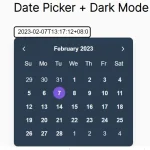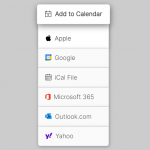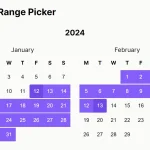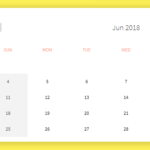| Author: | GramThanos |
|---|---|
| Views Total: | 16,023 views |
| Official Page: | Go to website |
| Last Update: | October 4, 2018 |
| License: | MIT |
Preview:

Description:
jsCalendar is a standalone JavaScript library that helps you create customizable inline calendars on the webpage page.
More features:
- 3 built-in themes: Default, Material Design, and Classic.
- Each theme has 5 colors: blue, yellow, orange, red, green.
- Tons of options, events and API methods.
- i18n. Supports 9+ languages.
Basic usage:
Include the jsCalendar’s JavaScript and Stylesheet on the html page.
<link rel="stylesheet" href="jsCalendar.css"> <script src="jsCalendar.js"></script>
Include a language file of your choice:
<script src="jsCalendar.lang.de.js"></script>
Create an element for the calendar.
<div id="my-calendar"></div>
To initialize the calendar automatically, just add the Class ‘auto-jsCalendar’ to the container element.
<div class="auto-jsCalendar"></div>
Or via JavaScript:
// Get the element
var element = document.getElementById("my-calendar");
// Create the calendar
jsCalendar.new(element);Set the selected date on init.
jsCalendar.new(element, "30/01/2017");
Apply a theme of your choice to the calendar.
<!-- Material theme --> <div class="auto-jsCalendar material-theme"></div> <!-- Classic theme --> <div class="auto-jsCalendar classic-theme"></div> <!-- Green theme --> <div class="auto-jsCalendar green"></div> <!-- Blue theme --> <div class="auto-jsCalendar blue"></div> <!-- Yellow theme --> <div class="auto-jsCalendar yellow"></div> <!-- Orange theme --> <div class="auto-jsCalendar orange"></div> <!-- Red theme --> <div class="auto-jsCalendar red"></div>
All possible calendar options.
jsCalendar.new(element, "30/01/2017",{
// language
language : "en",
// Enable/Disable date's number zero fill
zeroFill : false,
// Custom month string format
// month: Month's full name "February"
// ##: Month's number "02"
// #: Month's number "2"
// YYYY: Year "2017"
monthFormat : "month",
// Custom day of the week string forma
// day: Day's full name "Monday"
// DDD: Day's first 3 letters "Mon"
// DD: Day's first 2 letters "Mo"
// D: Day's first letter "M"
dayFormat : "D",
// 1 = monday
firstDayOfTheWeek: 1
// Enable/Disable month's navigation buttons.
navigator : true,
// both | left | right
navigatorPosition : "both",
// min date
min : false,
// max date
max : false
});API methods.
// goto the next month
jsCalendar.next();
// goto the previous month
jsCalendar.previous();
// set a new date
jsCalendar.set("30/01/2017");
// refresh the calendar
jsCalendar.refresh();
// goto a specified date
jsCalendar.goto("30/01/2017");
// rest the calendar
jsCalendar.reset();
// change the calendar language
jsCalendar.setLanguage("de");
// set min/max dates
jsCalendar.min("now");
jsCalendar.max("now");
Events available.
jsCalendar.onDateClick(function(event, date){
// On day click
});
jsCalendar.onMonthChange(function(event, date){
// On month change
});Changelog:
10/04/2018
- Fixed translator and language name
- General code cleanup and some CSS fixes











Hi is there a way to determine min date as in current date and max date, current date =1year?
Great resource – thanks!